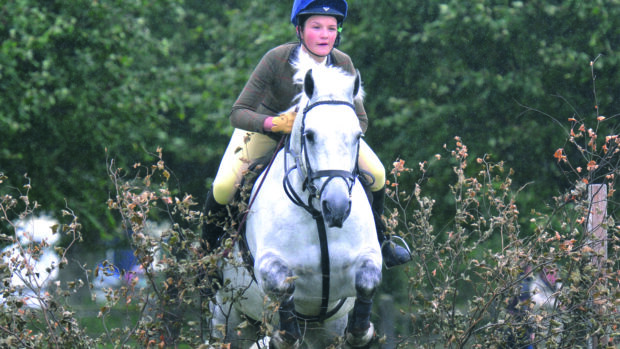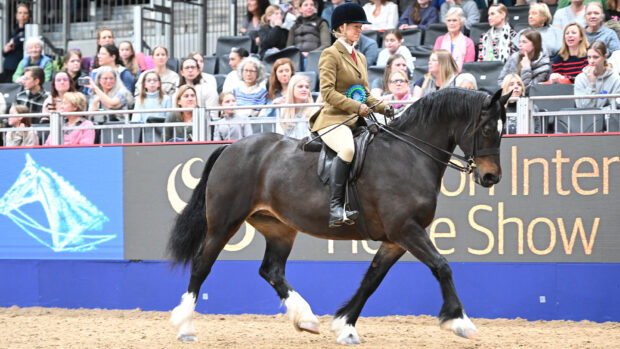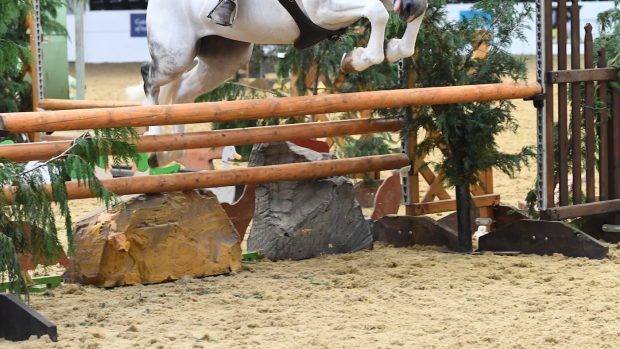Have you ever watched a working hunter pony (WHP) class and wondered what it was that made the winning animal stand out from the crowd? Whether you’re aiming for your first WHP class or want to improve your results this season, the following expert advice on what the judges do and don’t want to see will help put you on the road to success:
Classes and height divisions
Under British Show Pony Society (BSPS) rules, WHP classes are divided into height sections; 133cm, 143cm, 153cm and intermediates (horses exceeding 148cm but not exceeding 158cm.) Each class has relevant rider age restrictions. There are also two mini classes, cradle stakes (not exceeding 122cm. Riders not to have attained their 11th birthday before 1st January in the current year) and nursery stakes (not exceeding 133cm. Riders not to have attained their 12th birthday before 1st January in the current year.) A mini WHP championship follows both these classes and the main height classes have their own championship.
Each class is split into two phases. The first phase awards 50 marks for jumping (marks deducted for faults) and 20 marks for style, while the second phase gives 10 for manners and way of going and a further 20 for conformation, type and freedom of action.
What are the judges looking for?
A plaited working hunter pony, like a show hunter, should possess qualities that are recognised in the hunting field. These include good manners, ground-covering movement and a bold jumping style. A WHP should be a scaled down middleweight hunter and have the same quality, while also having plenty of bone and substance.
Judges look for combinations going forward in a balanced rhythmical canter, meeting each fence without a break of stride and showing harmony between pony and rider.
Continued below…
Like this? You may also enjoy reading these:
H&H’s guide on how to impress the judges on an ex-racehorse
H&H’s guide to show hunter pony classes: what the judge is looking for and how to win
Subscribe to Horse & Hound magazine today – and enjoy unlimited website access all year round
Jumping phase
“When it comes to the jumping round I really like to see ponies going in a nice rhythm with the rider being able to soften their hands in front of a fence in order that the ponies can adjust their stride and judge the fence themselves,” says BSPS judge Aly Boswell. “This might result in them coming in deep to the odd fence, but that in my opinion shows the real potential of the pony to look after itself and be a safe ride for a child.”
“When a rider comes into the ring to present themselves to the steward a lot of the more experienced children ride in on a relaxed rein and stand still nicely while making themselves known. However, many others keep a tight contact causing the pony to jiggle about and look rather tense, whereas a nice pat on the neck and a looser contact would make the initial impression a better one.
“I also look to see what bit a pony has in its mouth when it comes into the ring. If it’s a strong one I’ll wait to see if it goes quite sweetly in it, in which case I wouldn’t mark it down as in some cases the rider may have just moved up a class height.”
Individual show
The judge does not ride WHPs and competitors must perform an individual show.
“I like to see a settled, obedient pony doing their individual show,” says Aly. “I personally don’t like to see extended trot – just a happy, relaxed pony showing its regular paces, doing nice changes of leg at canter and culminating in a decent gallop.
“I don’t like to see children galloping while still sitting nearly upright in the saddle. I think they should have their bottom out of the saddle and going with the pony until they want to go back to canter. Then the rider should sit on the saddle in an upright position to aid the transition.
“All children are taught to salute the judge on finishing, but a nice neat movement is all that is required. I dread some of the waving flourishes that one receives these days.”
Conformation
Good bone
“When the ponies are stripped off for their conformation mark, most importantly I like to see if they have enough bone to be classed as a WHP,” states Aly. “I like a nice short coupled pony that is up in front and has enough neck to keep their rider in the saddle, should there be a slight jumping mistake.”
Nice legs
“Moving to their legs I like to think they have a pair of front feet and move straight,” says Aly. “I think that blemishes should be tolerated in a working pony, but obviously depends on the size and position.”
Present ponies correctly
“Time should be spent teaching children who aim to compete in these classes how to stand their pony up to the best of its ability,” suggests Aly.
“For example a pony with a short neck needs to be tempted by holding grass to draw its neck slightly forward, not held on tightly with its nose nearly touching its chest.”
Tack and turnout
Working hunter ponies should be shown with manes plaited.
“The turnout of the WHP is similar to show hunters,” says BSPS judge Robert Parker-Jones.
Grackle nosebands are allowed in WHP classes, as well as martingales. It’s also within the rules for riders to use protective boots on the fore limbs of their ponies for the jumping phase, although these must be removed for the judging of the conformation section.
“The majority of working ponies come forward wearing nice plain tack with the riders in tweed jackets, “ says Aly. “My only gripe is that I would prefer not to see girls wearing bright red or other multi-coloured ribbons, but sticking to brown, in keeping with their ponies.”
BSPS star judge Fiona Dymond concurs.
“Avoid too much bling,” she says. “Turnout should be smart and workmanlike. Avoid pink check jackets, sparkly hats, diamantes on ties and brass top bandmaster sticks.
“Opt for a smart green or brown-based tweed, a more subtle tie and not too large hair bows.”
Riders should
- “Ride on the outside track, find a space and focus on the pony’s way of going,” says Robert.
- “Find a space and keep out on the go round,” adds Fiona. “You don’t need to be running the judge down to get noticed. If you are going well it won’t go unnoticed.
- “If galloping all together or in fours, find a space and extend and pull up gradually in front of the judge.”
- Be polite to judges, stewards and other exhibitors.
- “Even when you’re disappointed with your result, raise a smile and a ‘thank you’,” says Robert.
- “Plan your individual performance so that it demonstrates all paces, especially the walk and gallop,” adds Robert.
- “And, if second placed animals are eligible for championships, make sure you’re present.”
Riders shouldn’t…
- Forget to gallop: “The rule book states that the gallop is an essential part of a WHP performance so make sure you do it,” says Fiona. “It shouldn’t be a mad scramble though — ease in and out of a few good strides.”
- “Ride a small circle so that you pass the judge more often than others in the class,” suggests Robert.
- “Try and reinvent traditional turnout and dress in an attempt to get noticed,” adds Robert.
Where to compete
All major shows usually run classes for WHPs of all heights, culminating in the WHP championship. Some shows run mixed height WHP classes.
The biggest accolades a WHP can win are the Royal International (RIHS) WHP championship, or the WHP of the year final held at Horse of the Year Show (HOYS) in October.
In 2019, 143cm campaigner Star Smokey and Leyla Wheelwright were championed at the RIHS. The 2019 HOYS WHP champion was 133cm mare Coco Bongo who went on to stand supreme pony with her jockey Chloe Lemieux.
Horse & Hound magazine, out every Thursday, is packed with all the latest news and reports, as well as interviews, specials, nostalgia, vet and training advice. Find how you can enjoy the magazine delivered to your door every week, plus options to upgrade to access our H&H Plus online service which brings you breaking news as it happens as well as other benefits.




